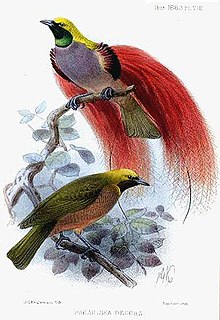
Sexual selection is a mode of natural selection in which members of one biological sex choose mates of the other sex to mate with, and compete with members of the same sex for access to members of the opposite sex. These two forms of selection mean that some individuals have greater reproductive success than others within a population, for example because they are more attractive or prefer more attractive partners to produce offspring. For instance, in the breeding season, sexual selection in frogs occurs with the males first gathering at the water's edge and making their mating calls: croaking. The females then arrive and choose the males with the deepest croaks and best territories. In general, males benefit from frequent mating and monopolizing access to a group of fertile females. Females can have a limited number of offspring and maximize the return on the energy they invest in reproduction.

In biology, mating is the pairing of either opposite-sex or hermaphroditic organisms, usually for the purposes of sexual reproduction. Some definitions limit the term to pairing between animals, while other definitions extend the term to mating in plants and fungi. Fertilization is the fusion of two gametes. Copulation is the union of the sex organs of two sexually reproducing animals for insemination and subsequent internal fertilization. Mating may also lead to external fertilization, as seen in amphibians, fishes and plants. For the majority of species, mating is between two individuals of opposite sexes. However, for some hermaphroditic species, copulation is not required because the parent organism is capable of self-fertilization (autogamy); for example, banana slugs.
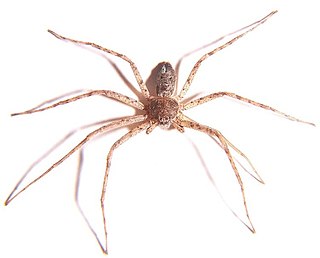
Philodromidae, also known as philodromid crab spiders and running crab spiders, is a family of araneomorph spiders first described by Tord Tamerlan Teodor Thorell in 1870. It contains over 600 species in thirty genera. Most are dull colored- brown, gray, yellowish or mottled with a leaf-like cardiac mark on the anterior dorsal abdomen, and seldom reach above 10 millimetres (0.39 in) long. None of the species build webs, but they do use silk for draglines and egg sacs.

The redback spider, also known as the Australian black widow, is a species of highly venomous spider believed to originate in South Australia or adjacent Western Australian deserts, but now found throughout Australia, Southeast Asia and New Zealand, with colonies elsewhere outside Australia. It is a member of the cosmopolitan genus Latrodectus, the widow spiders. The adult female is easily recognised by her spherical black body with a prominent red stripe on the upper side of her abdomen and an hourglass-shaped red/orange streak on the underside. Females usually have a body length of about 10 millimetres (0.4 in), while the male is much smaller, being only 3–4 mm (0.12–0.16 in) long.
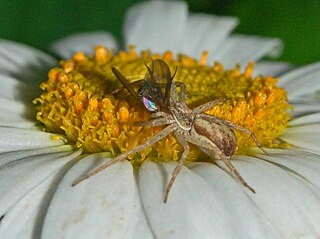
Thanatus is a genus of false crab spiders described by Carl Ludwig Koch in 1837, belonging to the order Araneae, family Philodromidae.
A pseudo-penis is any structure found on an animal that, while superficially appearing to be a penis, is derived from a different developmental path.

Misumena vatia is a species of crab spider with holarctic distribution. In North America, it is called the goldenrod crab spider or flower (crab) spider. It is commonly found hunting in goldenrod sprays and milkweed plants in the autumn. They are called crab spiders because of their unique ability to walk sideways as well as forwards and backwards. A female's torso can grow up to 10 mm (0.39 in) while males are quite small, reaching 5 mm (0.20 in) at most. These spiders are yellow or white, and have the ability to change between these two colors based on their surroundings. They have a complex visual system, with eight eyes, that they rely on for prey capture and for their color changing abilities. Sometimes, if Misumena vatia consume colored prey, the spider itself will take on that color.

The Entelegynae or entelegynes are a subgroup of araneomorph spiders, the largest of the two main groups into which the araneomorphs were traditionally divided. Females have a genital plate (epigynum) and a "flow through" fertilization system; males have complex palpal bulbs. Molecular phylogenetic studies have supported the monophyly of Entelegynae.
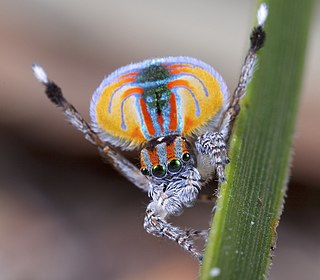
Maratus volans is a species in the jumping spider family (Salticidae), belonging to the genus Maratus. These spiders are native to certain areas in Australia and occupy a wide distribution of habitats. They have a specialized visual system that allows them to see the full visible spectrum as well as in the UV-range; this helps them detect and pursue prey. Males of this species are characterized by their colorful abdomen flaps that are used to attract females during courtship.

Sexual cannibalism is when a female cannibalizes her mate prior to, or after copulation. It is a trait observed in many arachnid orders and several insect orders. Several hypotheses to explain this seemingly paradoxical behavior have been proposed. The adaptive foraging hypothesis, aggressive spillover hypothesis and mistaken identity hypothesis are among the proposed hypotheses to explain how sexual cannibalism evolved. This behavior is believed to have evolved as a manifestation of sexual conflict, occurring when the reproductive interests of males and females differ. In many species that exhibit sexual cannibalism, the female consumes the male upon detection. Females of cannibalistic species are generally hostile and unwilling to mate; thus many males of these species have developed adaptive behaviors to counteract female aggression.

Traumatic insemination, also known as hypodermic insemination, is the mating practice in some species of invertebrates in which the male pierces the female's abdomen with his aedeagus and injects his sperm through the wound into her abdominal cavity (hemocoel). The sperm diffuse through the female's hemolymph, reaching the ovaries and resulting in fertilization.
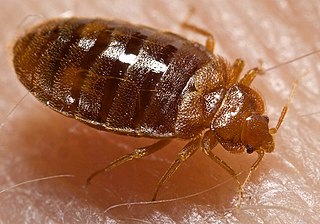
Cimex is a genus of insects in the family Cimicidae. Cimex species are ectoparasites that typically feed on the blood of birds and mammals. Two species, Cimex lectularius and Cimex hemipterus, are known as bed bugs and frequently feed on humans, although other species may parasitize humans opportunistically. Species that primarily parasitize bats are known as bat bugs.

Phonognatha graeffei, referred to as the leaf curling spider, is a common Australian spider found in woodlands and urban areas in the northeastern, eastern and southern states. A small member of the family Araneidae, the orb-weavers, it was previously placed in Tetragnathidae.
The spermalege is a special-purpose organ found in bed bugs that appears to have evolved to mitigate the effects of traumatic insemination. The spermalege has two embryologically distinct parts, known as the ectospermalege and mesospermalege. The evolution of the spermalege as a female counter-adaptation for traumatic insemination was first proposed by Jacques Carayon in 1966.

The two palpal bulbs – also known as palpal organs and genital bulbs – are the copulatory organs of a male spider. They are borne on the last segment of the pedipalps, giving the spider an appearance often described as like wearing boxing gloves. The palpal bulb does not actually produce sperm, being used only to transfer it to the female. Palpal bulbs are only fully developed in adult male spiders and are not completely visible until after the final moult. In the majority of species of spider, the bulbs have complex shapes and are important in identification.

Philodromus aureolus, the wandering crab spider, is a mainly European running crab spider of the family Philodromidae. The taxonomy of the species group named after Philodromus aureolus is in a state of flux and a number of new species have recently been recognised.

Thanatus formicinus is a species of spider in the family Philodromidae. It has a Holarctic distribution.
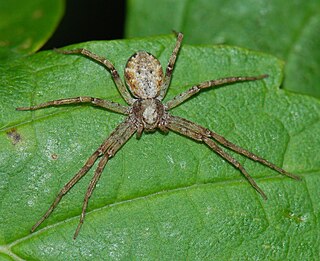
Philodromus cespitum is a species of running crab spider in the family Philodromidae. It is found in North America, Europe, North Africa, and parts of the Middle East and Asia. P. cespitum is a foliage-dweller, and is the most abundant species found in European fruit orchards. It acts as a biological control by preying on orchard pests. P. cespitum is a diurnal ambush hunter and preys on aphids, insects, and occasionally competitor spider species. Males court females by tapping on the females’ bodies with their forelegs. They then insert a genital plug into the female during copulation. Unlike in many other spider species, subsequent males can mate with plugged females by removing part of the plug prior to copulation. Males discriminate among females based on virginity and plug size, and can determine these factors using the females’ draglines and plug samples.

Thanatus vulgaris is a species of running crab spider in the family Philodromidae. It is found in North America, Europe, North Africa, Turkey, Israel, Caucasus, a range from Russia, Central Asia, China, and Korea.
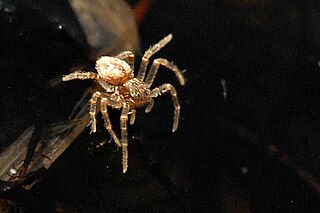
Thanatus striatus is a species of running crab spider in the family Philodromidae. It is found in North America, Europe, Turkey, a range from Russia, and Central Asia.

















